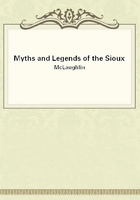
第19章 THE BOUND CHILDREN(1)
There once lived a widow with two children--the elder a daughter and the younger a son. The widow went in mourning for her husband a long time. She cut off her hair, let her dress lie untidy on her body and kept her face unpainted and unwashed.
There lived in the same village a great chief. He had one son just come old enough to marry. The chief had it known that he wished his son to take a wife, and all of the young women in the village were eager to marry the young man. However, he was pleased with none of them.
Now the widow thought, "I am tired of mourning for my husband and caring for my children. Perhaps if I lay aside my mourning and paint myself red, the chief's son may marry me."
So she slipped away from her two children, stole down to the river and made a bathing place thru the ice. When she had washed away all signs of mourning, she painted and decked herself and went to the chief's tepee. When his son saw her, he loved her, and a feast was made in honor of her wedding.
When the widow's daughter found herself forsaken, she wept bitterly. After a day or two she took her little brother in her arms and went to the tepee of an old woman who lived at one end of the village. The old woman's tumble down tepee was of bark and her dress and clothing was of old smoke-dried tent cover. But she was kind to the two waifs and took them in willingly.
The little girl was eager to find her mother. The old woman said to her: "I suspect your mother has painted her face red. Do not try to find her. If the chief's son marries her she will not want to be burdened with you."
The old woman was right. The girl went down to the river, and sure enough found a hole cut in the ice and about it lay the filth that the mother had washed from her body. The girl gathered up the filth and went on. By and by she came to a second hole in the ice.
Here too was filth, but not so much as at the previous place. At the third hole the ice was clean.
The girl knew now that her mother had painted her face red. She went at once to the chief's tepee, raised the door flap and went in. There sat her mother with the chief's son at their wedding feast.
The girl walked up to her mother and hurled the filth in her mother's face.
"There," she cried, "you who forsake your helpless children and forget your husband, take that!"
And at once her mother became a hideous old woman.
The girl then went back to the lodge of the old woman, leaving the camp in an uproar. The chief soon sent some young warriors to seize the girl and her brother, and they were brought to his tent.
He was furious with anger.
"Let the children be bound with lariats wrapped about their bodies and let them be left to starve. Our camp will move on," he said.
The chief's son did not put away his wife, hoping she might be cured in some way and grow young again.
Everybody in camp now got ready to move; but the old woman came close to the girl and said:
"In my old tepee I have dug a hole and buried a pot with punk and steel and flint and packs of dried meat. They will tie you up like a corpse. But before we go I will come with a knife and pretend to stab you, but I will really cut the rope that binds you so that you can unwind it from your body as soon as the camp is out of sight and hearing."
And so, before the camp started, the old woman came to the place where the two children were bound. She had in her hand a knife bound to the end of a stick which she used as a lance. She stood over the children and cried aloud:
"You wicked girl, who have shamed your own mother, you deserve all the punishment that is given you. But after all I do not want to let you lie and starve. Far better kill you at once and have done with it!" and with her stick she stabbed many times, as if to kill, but she was really cutting the rope.